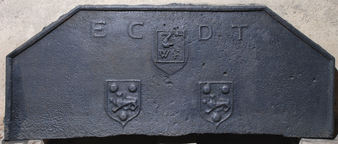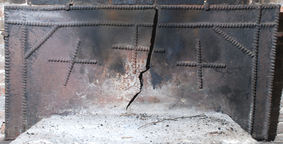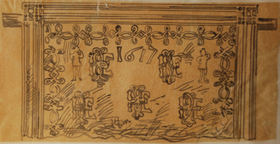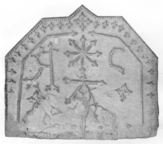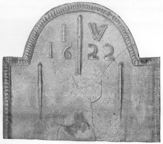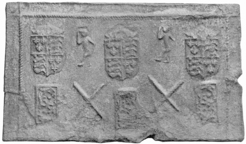-
1199
Description: Rectangular, plain plate; top centre, cross probably formed of a repeated length of dowel helically wrapped with a leather strap; top right, a buckle impressed four times, the top two with their prongs inclined towards each other, and the bottom two with prongs vertical and parallel; left of the cross, a shield, indented at the top, charged with a bird upon a branch, to the left of which is a 'renaissance' style shield stamp with a 'PL' monogram above two [?]bougets.
Notes: The four buckles suggest a connection with the Pelham family whose badge it is. The protrusion low on the right edge of the fireback is probably the stub of a runner through which the cast iron was run into the mould from a temporary basin formed in the casting sand. The given width dimension assumes the crack across the fireback is closed.
- Decoration tags:
- rectangular (shape)
- none (edging)
- simple stamps
- carved stamps
- heraldic
- apotropaic
- objects
Manufactured: in the early- to mid-16th century in the Weald area of England.
Current location: in private hands, Framfield, East Sussex, England.
- Attached to series:
- Bird shield series
- Pelham family firebacks
- Metalware stamp firebacks
-
67
Description: Pediment and frieze resting on fluted Tuscan pilasters; plain podium base; rectangular central panel with double fillet edge divided into four with central panel containing initials; date in tympanum; narrow rectangular panels on each side from base to cornice.
Notes: An early example of the use of classical architectural elements in an English fireback.
Inscription: 1568 ER
- Decoration tags:
- rectangular with pediment (shape)
- none (edging)
- whole carved pattern
- individual letters
- extension panels
- architectural
- text
Manufactured: in 1568 in the Weald area of England.
Current location: in private hands, Frant, East Sussex, England.
- Attached to series:
- 1568 Architectural series
- Date & initials firebacks
-
68
Description: Canted rectangle; ovolo edging (top and sides); symmetrically arranged, initials separated by overpressed, fillet edged stamp bearing letters WF surmounted by a bent arm holding a battleaxe issuing from a chapeau; beneath are two shields bearing the arms of Fowle.
Notes: The shield and crest stamps relate to William Fowle (1568-1634) and are those used on iron grave slabs in Wadhurst and Frant churches and in Maidstone museum, as well as on other firebacks. The initials have not been identified. The fireback was formerly in Riverhall, Wadhurst, built by William Fowle. Another casting with the same set of initials, but in a slightly different arrangement, has been noted (no. 1077), and Christy (1908 p.386) reported on another with slots for two firedogs.
Inscription: EC DT / WF
Arms: William Fowle, of Frant and Wadhurst
- Decoration tags:
- rectangular with canted top corners (shape)
- astragal (edging)
- carved stamps
- individual letters
- heraldic
- armorial
- text
Manufactured: in the early- to mid-17th century probably at Riverhall Furnace, Wadhurst in the Weald area of England.
Current location: in private hands, Frant, East Sussex, England.
- Attached to series:
- Fowle series
-
69
Description: Rectangular; twisted rope edging (top and sides); twisted rope lengths parallel to top and both sides and crossing at corners, with shorter rope lengths across inside angles; shorter rope lengths arranged in three crosses across middle of plate, the middle one higher than the other two.
Notes: A particularly large and elaborate arrangement of rope lengths. The crosses suggest Christian significance.
- Decoration tags:
- rectangular (shape)
- rope (edging)
- simple stamps
- apotropaic
- objects
Manufactured: in the 16th century in the Weald area of England.
Current location: in private hands, Freshfield, East Sussex, England.
- Attached to series:
- Rope design firebacks
-
949
Description: Rectangular; low-relief moulded edging along top, then down sides; double-looped 'lens' pattern stamp repeated six times across the top, inside the edging and, rotated, three times down each side; becapped human figure stamp, with his left arm raised to his head and his right arm akimbo, repeated in each top corner; between these, 'IE' monogram with continuous loop between the letters repeated five times, two in line above and three below, the centre one slightly raised; the date between the top two; a lifting handle on each side.
Notes: Said to have been at Horsham, Sussex; on another fireback, at the Old Manor, Upper Beeding in Sussex, cast with the same stamps, and also dated 1617, the monogram stamp is clearly carved on a 'renaissance' shield, indicating that in this instance the stamps were not impressed as deeply. Drawing by J. Lewis André in the J. Starkie Gardner Collection, Victoria & Albert Museum, Archive of Art and Design (AAD/2014/8). Possibly the fireback referred to by Lewis André in 1882 as belonging to a Miss Alman, of East Street, Horsham (Sussex Archaeological Collections XXXII, p.76).
Inscription: IE 1617 IE / IE IE IE
- Decoration tags:
- rectangular (shape)
- complex individual (edging)
- carved stamps
- individual numbers
- lifting handles
- monogram
- text
- humans
Manufactured: in 1617 in the Weald area of England.
Current location: not known.
Citation: Gardner, J. S., 1898, 'Iron Casting in the Weald', Archaeologia, 56, 1, pp. 133-164.
Citation: Gardner, J. S., 30 Apr 1904, 'An old fire-back' (letter), Country Life, p. 647.
-
298
Description: Pentagonal with a small triangular arch, centre top; twisted rope edging (top and sides); in arch, cross formed of small fleurs-de-lys; row of small fleurs inside rope edging, lower half of sides plain; length of twisted rope each side, parallel to edges, with small fleur terminal at top end; upper centre, rope escarbuncle with fleur terminals between ‘R’ and ‘C’ (both of rope with fleur terminals, ‘R’ reversed); ‘A’ below escarbuncle (also rope with fleur terminals, with cross bar above); fleur cross below ‘R’.
Notes: Twisted rope with fleur terminals is seen on several firebacks with stamps otherwise associated; it is a form paralleled on firebacks from the Champagne area of France. The escarbuncle is the principal charge on the arms of the Duchy of Cleves, possibly associating this fireback with the brief marriage of Henry VIII and Anne of Cleves. Formerly at Warnham Court, Sussex; illustrated in Gardner 1898, p. 146.
Inscription: R A C [inverted triad]
- Decoration tags:
- rectangular with canted top corners and triangular arch (shape)
- rope (edging)
- simple stamps
- objects
Manufactured: in the mid- to late-16th century possibly at Pounsley Furnace, Framfield in the Weald area of England.
Current location: not known.
Citation: Gardner, J. S., 1898, 'Iron Casting in the Weald', Archaeologia, 56, 1, pp. 133-164.
- Attached to series:
- Pounsley series
- Rope design firebacks
- Fleur rope terminal series
-
1284
Description: Arched rectangular shape; gadrooned edging (top and sides); initials, in separate stamps, at top of arch; date probably in separate stamps, below; spindle used as a stamp repeated three times, one between date and initial stamps, the other two below to left and right.
Notes: The same base board and spindle have been used for other firebacks of the same period. A similar casting (no. 299) has the 'W' in a slightly different position. Formerly at Warnham Court, Sussex.
Inscription: I W / 16 22
- Decoration tags:
- rectangular with round arch (shape)
- gadrooned (edging)
- simple stamps
- individual letters
- individual numbers
- text
- objects
Manufactured: in 1622 possibly at Cuckfield Furnace in the Weald area of England.
Current location: not known.
Citation: Gardner, J. S., 1898, 'Iron Casting in the Weald', Archaeologia, 56, 1, pp. 133-164.
- Attached to series:
- Spindle series
- Spindle/distaff firebacks
- Date & initials firebacks
-
301
Description: Rectangular; inset twisted rope edging (top and sides); crowned Tudor royal shield stamp repeated three times across top, each pair interspersed with an 'imp' figure with right arm raised; below each shield, rectangular stamp with indistinct ?rose design, each pair interspersed with a twisted rope saltire.
Notes: The crowned shield and 'imp' figure associate this fireback with others of the Royal series; the saltires may have apotropaic significance. Illustration from Starkie Gardner 1898, p. 143.
Arms: Tudor royal arms of England
- Decoration tags:
- rectangular (shape)
- none (edging)
- simple stamps
- carved stamps
- heraldic
- apotropaic
- armorial
- royal
- humans
- objects
Manufactured: in the mid-16th century in the Weald area of England.
Current location: Stone House, Rushlake Green, Warbleton, East Sussex, England.
Citation: Gardner, J. S., 1898, 'Iron Casting in the Weald', Archaeologia, 56, 1, pp. 133-164.
- Attached to series:
- Royal series
-
70
Description: Arched rectangular shape; simulated twisted rope edging (top & sides); symmetrical arrangement of fleurs de lys (two types - 2 and 1), diamond shapes (2) and cross-cut squares (4) includes the monogram in which the letters I and F are separated by a small, hollow diamond stamp, the M being above; interspersed symmetrical arrangement of raised spots (8).
Notes: The initials, as with other triple-lettered forms, in which the middle letter is set apart from the other two, may relate to a married couple where their surname initial is M. Another example seen has shown that the pattern was formed of five angular, uneven-sized planks battened together.
Copies of this fireback are known.
Inscription: 1613 / M / I F
- Decoration tags:
- rectangular with round arch (shape)
- simulated rope (edging)
- simple stamps
- carved stamps
- individual letters
- individual numbers
- planklines
- heraldic
- text
Manufactured: in 1613 in the Weald area of England.
Current location: Godalming Museum, Godalming, Surrey, England.
Museum number: B980.400 (part of the Godalming Museum museum group)
- Attached to series:
- Diamond series
-
1207
Description: Rectangular; twisted rope edging (top and sides); in the upper part of the plate, between a leopard passant guardant sinister (on the left) and a leopard passant (on the right), a domed roundel bearing an off-centre smaller roundel within an edged circular depression, repeated four times in diamond pattern, with the smaller roundels orientated towards the centre of the arrangement; in the top corners, two more domed roundels, their smaller roundels orientated towards the bottom of the plate.
Notes: The roundel stamp has not been noted on any other firebacks. One of the legs of the leopard on the left and both legs of the leopard on the right are missing, suggesting that the stamps, which appear complete on many firebacks, were well used and had been damaged; this suggests a relatively late use of these stamps. Gorringe's auction, Lewes, lot 82, 2 Aug 2021 (£170). Bishop & Miller Auctioneers, Stowmarket, 27 Jan 2022, lot 383 (£2,900).
Copies of this fireback are known.
- Decoration tags:
- rectangular (shape)
- rope (edging)
- simple stamps
- carved stamps
- heraldic
- animals
- objects
Manufactured: in the mid- to late-16th century in the Weald area of England.
Current location: not known.
- Attached to series:
- Royal series


